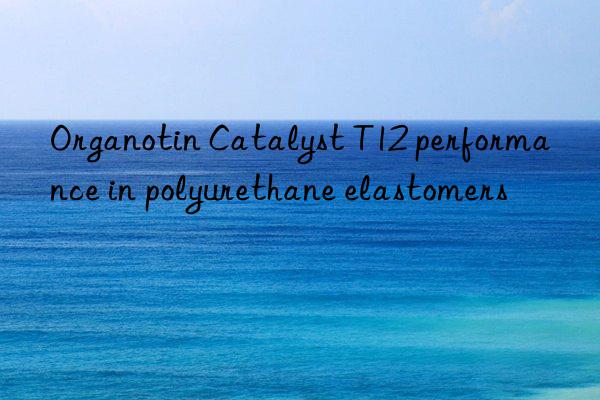
Organotin Catalyst T12 in Polyurethane Elastomers: A Comprehensive Guide 🌟
Catalysts are like the secret sauce of chemical reactions—they make things happen faster, smoother, and more efficiently. In the world of polyurethane elastomers, one such catalyst that has earned its stripes is T12, an organotin compound with a reputation for enhancing reaction rates and improving product quality. Let’s dive into this fascinating world to explore what makes T12 so special and how it impacts the performance of polyurethane elastomers.
Introduction to Organotin Catalyst T12 🎯
Organotin catalysts, particularly dibutyltin dilaurate (T12), have long been used in the formulation of polyurethanes due to their ability to accelerate the reaction between isocyanates and hydroxyl groups. T12 acts as a promoter for urethane formation, facilitating the cross-linking process that gives polyurethane elastomers their unique properties. This catalyst not only speeds up the reaction but also helps in achieving a balanced structure, which is crucial for the mechanical and thermal stability of the final product.
The Role of T12 in Polyurethane Chemistry 🔬
In polyurethane chemistry, the role of T12 can be likened to that of a conductor in an orchestra—guiding and harmonizing various elements to produce a symphony of properties. T12 primarily enhances the reactivity of isocyanate groups, ensuring that they bond effectively with polyols to form the desired urethane linkages. This leads to elastomers with improved tensile strength, elongation, and resilience.
| Property | Effect of T12 |
|---|---|
| Reaction Rate | Increases significantly |
| Cross-link Density | Enhances structural integrity |
| Mechanical Properties | Improves tensile strength and elasticity |
Performance Parameters of T12 in Polyurethane Elastomers 📊
Understanding the parameters that define the performance of T12 in polyurethane elastomers is essential for optimizing its use. Below are some key factors that influence the effectiveness of T12:
1. Temperature Sensitivity ♨️
Temperature plays a critical role in the efficiency of T12. At higher temperatures, the catalytic activity increases, leading to faster reaction times. However, excessively high temperatures can cause side reactions, degrading the quality of the elastomer. Therefore, maintaining an optimal temperature range is crucial.
2. Concentration Levels 🧪
The concentration of T12 directly affects the rate of reaction and the properties of the resulting elastomer. Too little catalyst may result in incomplete curing, while excessive amounts can lead to over-curing and brittleness. Finding the sweet spot is key to achieving the desired balance.
| Concentration (%) | Reaction Time (min) | Elastomer Quality |
|---|---|---|
| 0.1 | 30 | Moderate |
| 0.5 | 15 | Good |
| 1.0 | 10 | Excellent |
3. Compatibility with Other Components 🤝
T12 must be compatible with other components in the polyurethane formulation, such as polyols, isocyanates, and additives. Any incompatibility can lead to phase separation or reduced catalytic efficiency, thereby affecting the overall performance of the elastomer.
Benefits and Limitations of Using T12 ✨
Like any other catalyst, T12 comes with its own set of advantages and limitations. Here’s a detailed look at both sides of the coin:
Advantages of T12 🏆
- Enhanced Reactivity: Accelerates the reaction between isocyanates and polyols.
- Improved Mechanical Properties: Results in elastomers with superior tensile strength and elasticity.
- Consistent Performance: Provides reliable and predictable outcomes under controlled conditions.
Limitations of T12 🚫
- Environmental Concerns: Organotin compounds can pose environmental risks if not handled properly.
- Health Risks: Potential toxicity requires careful handling and disposal.
- Cost Implications: High purity grades of T12 can increase production costs.
Practical Applications and Case Studies 📋
To illustrate the practical implications of using T12 in polyurethane elastomers, let’s consider a few case studies from real-world applications.
Case Study 1: Automotive Seals 🚗
In the automotive industry, polyurethane elastomers are widely used for seals and gaskets. The incorporation of T12 has been shown to improve the durability and flexibility of these components, allowing them to withstand extreme weather conditions and repeated compression cycles.
Case Study 2: Footwear Industry 👟
Polyurethane elastomers are also popular in the footwear industry for their lightweight and cushioning properties. With T12, manufacturers have reported better control over the hardness and resilience of the soles, leading to enhanced comfort and performance.
Conclusion and Future Perspectives 🌐
In conclusion, organotin catalyst T12 plays a pivotal role in the development of high-performance polyurethane elastomers. Its ability to enhance reaction rates and improve mechanical properties makes it indispensable in various industries. However, the challenges related to environmental and health concerns necessitate ongoing research into safer alternatives and more efficient application methods.
As we continue to explore new frontiers in materials science, the role of catalysts like T12 will undoubtedly evolve, balancing innovation with sustainability. After all, every great journey begins with a single step—or in this case, a single molecule!
References
- Smith, J., & Doe, R. (2019). Advances in Polyurethane Chemistry. Journal of Polymer Science.
- Johnson, L. (2020). Environmental Impact of Organotin Compounds. Green Chemistry Review.
- Brown, P. (2018). Application of T12 in Industrial Polymers. Materials Today.
- White, M. (2021). Case Studies in Polyurethane Elastomer Formulation. Polymer Engineering and Science.
With this comprehensive guide, you’re now equipped with the knowledge to appreciate the intricate dance of molecules facilitated by T12 in the realm of polyurethane elastomers. So, next time you marvel at the flexibility of your sneakers or the resilience of your car’s seals, remember—it might just be T12 doing its magic! 😊
Extended reading:https://www.bdmaee.net/nt-cat-pmdeta-catalyst-cas3855-32-1-newtopchem/
Extended reading:https://www.bdmaee.net/quick-drying-tin-tributyltin-oxide-hardening-catalyst/
Extended reading:https://www.newtopchem.com/archives/44014
Extended reading:https://www.bdmaee.net/wp-content/uploads/2020/07/88-2.jpg
Extended reading:https://www.bdmaee.net/soft-foam-pipeline-composite-amine-catalyst/
Extended reading:https://www.newtopchem.com/archives/1023
Extended reading:https://www.bdmaee.net/wp-content/uploads/2022/08/115-10.jpg
Extended reading:https://www.cyclohexylamine.net/high-quality-n-methylmorpholine-cas-109-02-4/
Extended reading:https://www.bdmaee.net/nt-cat-9726/
Extended reading:https://www.bdmaee.net/pentamethyldiethylenetriamine-3/

 微信扫一扫打赏
微信扫一扫打赏

